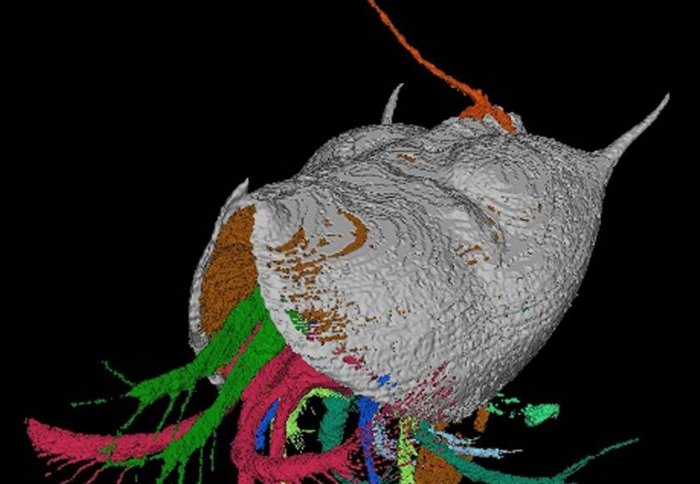Fossil parasite discovery reveals missing evolutionary step

3D scan showing false-coloured parasite (orange) attached to an ostracod shell
425-million-year-old parasites, related to modern lung-dwelling parasites, have been found attached to the outside of an ancient sea creature.
The ‘tongue worms’ are a group of parasites that live exclusively inside vertebrates, especially those living on land, including humans. The discovery of an ancient relative of the parasite living on the outside of a small shelled sea creature reveals that they used to have a very different lifestyle.
Until now, only larvae of the parasite had been found. These came from rocks around 500 million years old, before the evolution of vertebrates, so scientists didn’t know how the adults lived at that time. The new fossil find shows that they survived on the outside of their hosts.
Before this, we knew these parasites must have done something else before moving into vertebrates, but it was all just guesses.
– Dr Mark Sutton
Tongue worms are not technically worms, but have a long, thin body and a head with two pairs of limbs. Today more than 140 species exist that live internally in the respiratory system of a host, which it enters when it is eaten.
The new fossil shows a host, in this case a species of ostracod (a group of micro-arthropods related to crabs, spiders and insects), surrounded by several tongue worms attached to various parts of the body. The tongue worms were entirely soft-bodied in life, meaning they do not usually preserve well as fossils. This is the first fossil tongue worm species to be found associated with its host.
The fossil, described today in a paper published in Current Biology, was found in 425-million year old rocks in Herefordshire, and described as ‘exceptionally well preserved.’ The parasites were identified as a new species, and named Invavita piratica, which means an ‘ancient intruder’ and ‘piracy’, referring to their parasitic lifestyle in the sea.
3d discovery
The team that made the discovery was led by the University of Leicester and included Dr Mark Sutton from the Department of Earth Sciences and Engineering at Imperial College London, who created a 3D model of the fossil.
“Fossils like this can genuinely cast light on things that would be otherwise fundamentally unknowable,” said Dr Sutton. “Before this, we knew these parasites must have done something else before moving into vertebrates, but it was all just guesses. We now have a much better idea of the evolutionary pathway this parasite took from external to internal.”
Lead author Professor Siveter from the University of Leicester said: “This discovery is important not only because examples of parasites are exceptionally rare in the fossil record, but also because the possible host of fossil tongue worms - and the origin of the lifestyle of tongue worms - has been the subject of much debate. This discovery affirms that tongue worms were ‘external’ parasites on marine invertebrate animals at least 425 million years ago.”
The research was supported by The Natural Environmental Research Council, together with the Leverhulme Trust, the John Fell Oxford University Press (OUP) Research Fund and Yale Peabody Museum of Natural History.
'A 425-Million-Year-Old Silurian Pentastomid Parasitic on Ostracods' by Siveter et al is published in Current Biology.
Article supporters
Article text (excluding photos or graphics) © Imperial College London.
Photos and graphics subject to third party copyright used with permission or © Imperial College London.
Reporter
Hayley Dunning
Communications Division